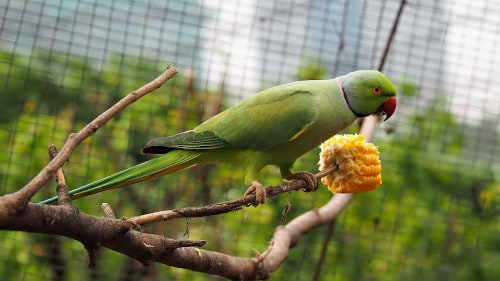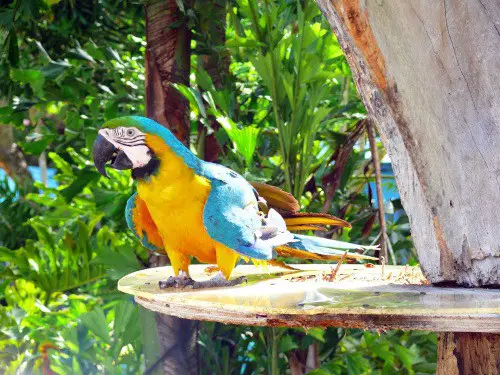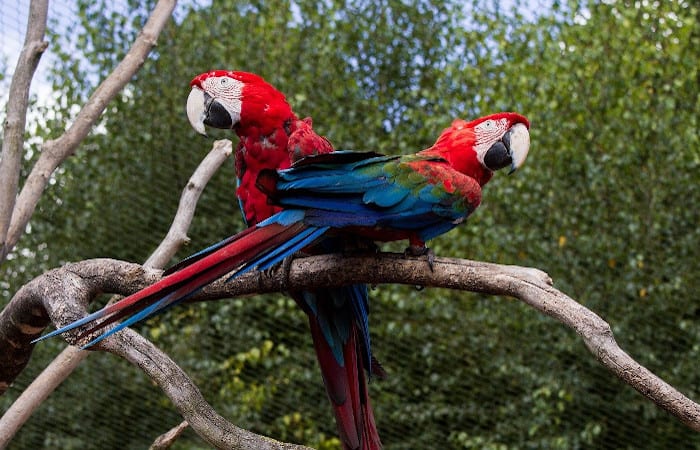Do you have a parrot at home? If so, you may have noticed that it wags its tail sometimes.
But why does it do that? Why is my parrot wagging its tail?
There are actually several reasons why your parrot may be wagging its tail.
In this blog post, we will discuss the 10 most common reasons and how to deal with them.
What are the common body languages in parrots?
While each parrot species has its own unique set of body language cues, there are some behaviors that are common to many parrots.
One of the most obvious is preening, which parrots use to clean and maintain their plumage.
Another typical behavior is foot tapping, which parrots often do when they are restless or excited.
Head shaking is another common cue, and it can indicate anything from fear to aggression.
Parrots also use their beaks to communicate, and a wide variety of cues can be conveyed through beak position and movement.
Finally, parrots often use their tails to express their emotions, and the position of the tail can provide a quick way to gauge a parrot’s mood.
By understanding these common body language cues, you can get a better sense of what your parrot is trying to communicate.
You may also like: Do Parrots Like Shiny Things?
Why is my parrot wagging its tail?
There are 10 reasons why your parrot might be wagging its tail.
Happy greeting
If your parrot wags its tail when you come home or approach it, it is likely a happy greeting.
This is a common behavior in social animals, and it’s a way for your parrot to show that it’s happy to see you.
Excitement
Another common reason for tail wagging is excitement. If your parrot is wagging its tail rapidly back and forth, it’s likely feeling excited about something.
This could be due to food, play, or anything else that your parrot enjoys.
Show interest
Tail wagging can also be a way for your parrot to show interest in something.
If you are doing something that your parrot wants to do, it may start wagging its tail as a way of indicating its interest.
For example, if you are eating and your parrot starts wagging its tail, it may be trying to tell you that it wants some food.
Enjoy interaction
Your parrot may wag its tail simply because it enjoys the interaction.
If you are petting or scratching your parrot and it starts wagging its tail, it is likely enjoying the attention.
This is a good sign that your parrot is happy and comfortable with you.
Attract attention
In some cases, your parrot may wag its tail in an attempt to attract your attention.
If you are not paying attention to your parrot and it starts wagging its tail, it may be trying to get you to focus on it.
This is usually a sign that your parrot wants some interaction or attention.
Attract mates
One possibility is that the parrot is trying to communicate something.
For example, if the parrot sees another bird it wants to mate with, it might start wagging its tail to signal its interest.
Warning sign
In some cases, tail wagging can be a warning sign.
If your parrot is wagging its tail slowly and deliberately from side to side, it may be feeling threatened or aggressive.
If you see this behavior, it’s best to give your parrot some space and remove any potential threats.
Fear or anxiety
Another possibility is that the parrot experiences negative emotions like fear or anxiety.
In this case, the tail-wagging may help to relieve some of the tension the parrot is feeling.
Boredom
It’s also possible that the parrot is simply bored and is looking for something to do.
If your parrot is wagging its tail slowly and seems uninterested in its surroundings, it may be boring.
In this case, try to provide some toys or other stimulation to help relieve the boredom.
Signs of Sickness
While tail-wagging can be perfectly normal behavior, there are some cases where it could be a sign of illness.
For example, if the tail-wagging is accompanied by other behaviors like weight loss or lethargy, it’s possible that the parrot is sick and you should take it to the vet.
These are just a few of the reasons why your parrot may be wagging its tail.
By understanding the body language cues of your parrot, you can get a better sense of what it is trying to communicate.
If you have any concerns about your parrot’s health or behavior, be sure to consult with a qualified veterinarian or animal behaviorist.
You may also like: Why Is Your Parrot Hissing?
What should I do if my parrot is wagging its tail excessively?

If your parrot is wagging its tail excessively, it could be a sign of fear and distress.
While it’s normal for parrots to wag their tails from time to time, excessive tail-wagging can be a cause for concern.
If your parrot is wagging its tail excessively and also showing other signs of distress, such as pacing or feather-plucking, it’s important to seek veterinary care.
Excessive tail-wagging can also be a sign of neurological problems, so it’s important to have your parrot examined by a qualified veterinarian.
With proper care and treatment, most parrots can lead happy and healthy lives.
You may also like: Why Do Parakeets Stand On One Foot?
Why is my parrot lifting its tail?

Parrots are intelligent creatures and their behaviors always have some meanings behind them.
If your parrot is crouching and lifting its tail, it can be a sign that your bird wants to poop.
When you see this posture and before the bird poops you can take it to a specific place if you are potty training your bird.
This is also a good time to give your bird some privacy if it wants to poop.
Conclusion
Why is my parrot wagging its tail?
There are a few reasons your parrot may be wagging its tail including boredom, fear or anxiety, and sickness.
Excessive tail-wagging can also be a sign of health problems.
If you have concerns about your parrot’s health or behavior, be sure to consult with a qualified veterinarian or animal behaviorist.
Most parrots can live long, happy, and healthy lives if they are properly cared for and treated.
